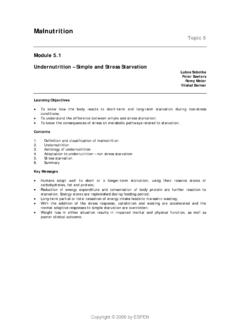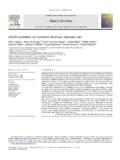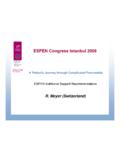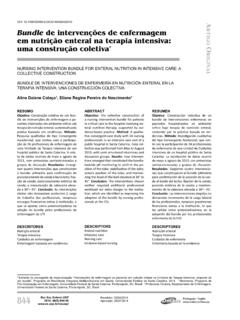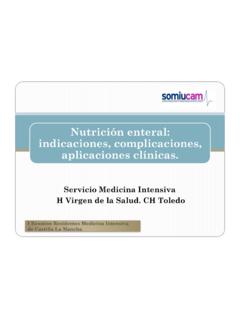Transcription of Nutritional Support in Intensive Care Unit (ICU) …
1 Copyright by ESPEN LLL Programme 2014 Nutritional Support in Intensive care Unit (ICU) Patients Topic 18 Module How to Maintain Homeostasis by nutrition care in the ICU Michael. J. Hiesmayr Division of Cardiothoracic & Vascular Anesthesia and Intensive care W hringerg rtel 18-20 Medical University Vienna Austria Learning objectives Understand the metabolic & endocrinological consequences of underfeeding Determine target for energy supply Methods to determine energy consumption Determine or estimate target for protein supply Identify patients at risk for the refeeding syndrome Learn key features of the refeeding syndrome Learn how to prevent the refeeding syndrome Content 1.
2 Introduction 2. Amount of protein needed 3. Amount of nutrients needed 4. Excessive nutrient intake The lung and ventilation The heart and circulation Endocrine system General signs and symptoms 5. Insufficient nutrient intake 6. Composition of the diet 7. Organs & nutrition Brain Cardiovascular system Lung Abdomen Kidney function Haematological system Endocrine system/metabolic equilibrium 8. Refeeding syndrome Pathophysiology Clinical symptoms Fluid equilibrium Glucose and lipid metabolism Thiamine deficiency Copyright by ESPEN LLL Programme 2014 Hypophosphataemia Hypomagnesaemia Hypokalaemia Treatment and prevention 9.
3 References 1. Introduction nutrition care is considered to be a basic and mandatory (essential) element of modern Intensive care treatment. Recommendations and guidelines exist from several professional organizations: ASPEN, Canadian Critical care Group and ESPEN. Their focus is on the indication for EN vs PN, amount of nutrient to be given, composition of all-in-one mixtures, and specific nutrients such as glutamine. No guidelines give any practical advice on how to maintain homeostasis during nutrition care or clinical problem solving in case of problems. Several large nutrition trials (1-5) have questioned some recommendations and are now integrated into this educational material.
4 nutrition care in the ICU has several challenges because the usual control mechanisms such as hunger, thirst may be missing during critical illness. On the one hand the control of the intake is under external control and on the other hand nutrients may have a complex interaction with various organ systems. A further challenge is that acute illness triggers an internal production of nutrients, usually called catabolism, that does not immediately stop when external nutrients are given. This catabolic response to injury is an essential mechanism to survive periods of missing intake.
5 The availability of certain nutrients impairs essential repair mechanisms such as autophagy, an internal mechanism to sequester injured organelles in autophagosomes (6). These four factors indicate that an integrative view is essential. The patient groups at highest risk for complications associated with nutrition care are obviously those at the extremes of body size, nutrient intake and actual disease: Table 1 - BMI very low or very high - Higher age - Prolonged starvation - High level of organ Support in the ICU - Severe physiological impairment The common denominator of all these conditions is an altered body composition.
6 Most conditions are associated with a decrease in lean body mass. This decrease may not be easily apparent because still maintained body fat is hiding the decrease in lean body mass. Various methods such as body impedance assessment (BIA), ultrasound, CT and MRI scans, but also functional measurements of muscle function, are used in specialist centres. Sarcopenia research has addressed this issue extensively (7). The challenge of nutrition science and care is to define to margins: the minimal requirement for macro- and micronutrients necessary for recovery from acute illness and the maximum tolerable margin.
7 A new concept is that minimal requirements and maximum tolerable concentrations vary during the course of an acute illness. This concept is shown for health and disease in Fig. 1a and b. During health a minimum of glucose (G) is needed for glucose dependent tissues such as the central nervous Copyright by ESPEN LLL Programme 2014 system, suprarenal glands, erythrocytes. If glucose supply from intake is not sufficient gluconeogenesis from protein (red arrow) can prevent a shortage. If glucose is available above needs and glycogen stores are full, storage into (yellow arrow) fat (F) occurs. High levels of amino acids (AA) are either oxidized and excreted or enter gluconeogenesis and are stored as fat.
8 Saturated (yellow bar) and unsaturated (green bar) fat are necessary in different amounts as energy sources but also to build cell membranes, hormones, etc. During acute illness needs change and endogenous mobilisation of macronutrients combines with external supply of nutrients. Thus the danger limit and the minimum may be changed. Recent research has shown that early large provision of nutrients is associated with storage of fat even in organs such as muscle where storage usually does not occur (8). Any level of nutrients below the minimum will induce an increased catabolic response mostly of the muscle.
9 Fig. 1 Margins for macronutrients between minimum and danger zone Energy expenditure remains relatively stable during the early phase of starvation and is only decreased by roughly 10% after 3 weeks of starvation. Energy expenditure is mostly determined by a few organs that have a high energy demand such as brain, liver, intestine, heart and kidney that represent 5% of body mass and 66% of energy expenditure. Only the brain maintains its weight during severe starvation. Thus the functional capacity of vital organs (especially heart, kidney, intestine) is decreased because structural protein has been lost during starvation.
10 Individuals with a regularly decreased lean body mass such as the elderly have a decrease in energy expenditure, which is about 1% per year above the age of 60 years. Of course these general estimates need to be adapted if functional status is different from the age group. In addition to these basic rules related to lean body mass, synthesis of acute phase proteins by the liver, faster turn-over of immune cells, uncontrolled muscle activity in delirium and repair of injured tissues modify energy expenditure. Protein handling follows another basic structure. Protein turnover is not similar to energy expenditure.


